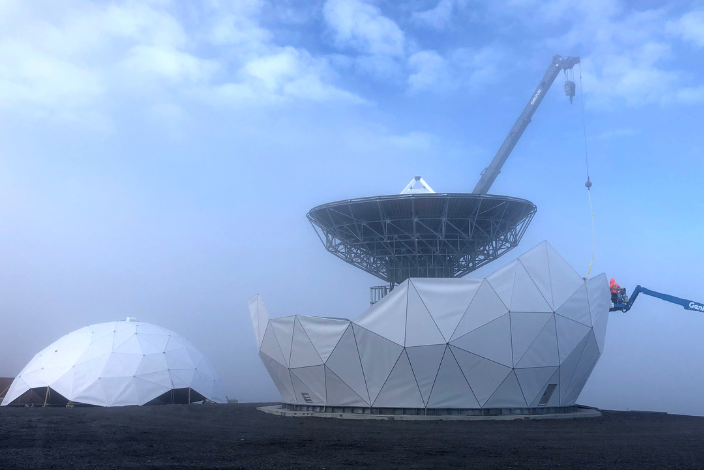Improving the communications infrastructure for the U.S. Antarctic Program (USAP) continues to be a priority for the National Science Foundation's (NSF) Office of Polar Programs (OPP). Given the remoteness of Antarctica, there are significant telecommunications challenges, including the sole reliance on satellite communications. Furthermore, due to the continent's location, there are a limited number of satellites whose orbit allows connection to Antarctica. Currently, internet support at NSF's McMurdo Station is equivalent to that of a rural single family home, but shared among anywhere from 100 to 1,000 people. USAP is making strides to improve the communciations capabilities and increase Internet accessibility across the continent.
Progress To-Date
Palmer Station now enjoys enhanced satellite communications capacity via a new service contract. Beginning in October 2020, the new service provider tripled the capability for the station, and at a lower cost.
South Pole Station is difficult to support as conventional communications satellites that hover over the Equator cannot be seen. However, the station now enjoys increased broadband satellite coverage using old U.S. Department of Defense (DoD) military communications satellites that have drifted into orbits that can be seen at the Station during parts of each day. A Defense Satellite Communications System (DSCS) satellite provides the highest “Internet” bandwidth for routine network operations to-date. Coordination continues with the DoD for access to additional DSCS satellites that can expand the limited time of day coverage.
At McMurdo Station, there have been two developments in 2022. A earth station called a Very Small Aperture Terminal (VSAT) was placed into operation, which doubled the broadband capacity to the station. In March 2022, a multi-year planning and construction collaboration with the NOAA Joint Polar Satellite System (NOAA/JPSS) completed the construction and commissioning of a large satellite earth station in the hills above McMurdo Station – The Ross Island Earth Station. Standing 4-stories tall, it will support future NSF and NOAA/JPSS communications requirementsand. Its development allows NSF to discontinue the use of its remote earth station located on the isolated Black Island, 20 miles away. NOAA/JPSS has awarded a new satellite communications services contract that, combined with the new earth station, provides increased broadband capacity for both agencies needs.
Testing and Future Initiatives
NSF is working with SpaceX to test Starlink, which provides high-speed, low-latency internet in hard-to-reach places via a constellation of satellites in low-Earth orbit. Testing in early September indicates that Starlink is able to connect McMurdo Station to the Internet at speeds much higher than presently seen at the station. Testing will continue as SpaceX continues to build coverage over the poles, which will enable NSF to evaluate if Starlink is suitable for all of its Antarctic stations, as well as summer camps in the interior of the continent.
OPP and NSF’s Office of Advanced Cybeinfrastructure (OAC) funded an Antarctic science workshop in June 2021 to explore the merit of a science sensor equipped submarine telecommunications cable that would connect McMurdo Station with New Zealand or Australia. Conducted by the University of Minnesota and University of Hawai’i, the workshop evaluated the essentially unlimited communications capability that could exist, while also providing a unique opportunity to instrument a vast stretch of the largely unexplored Southern Ocean with science sensors. The science benefits cover concepts as earthquake monitoring, tsunami early warning systems, and climate change monitoring. An industry standard initial feasibility study was completed in August 2022, providing an initial positive assessment of feasibility and a suggested cable route to meet science research objectives. Planning is now underway to continue more detailed assessments of feasibility. Recordings of the workshop, the workshop’s final report, and more information may be found at the organizer’s website. A publicly releasable edition of the study is anticipated in the near future.



